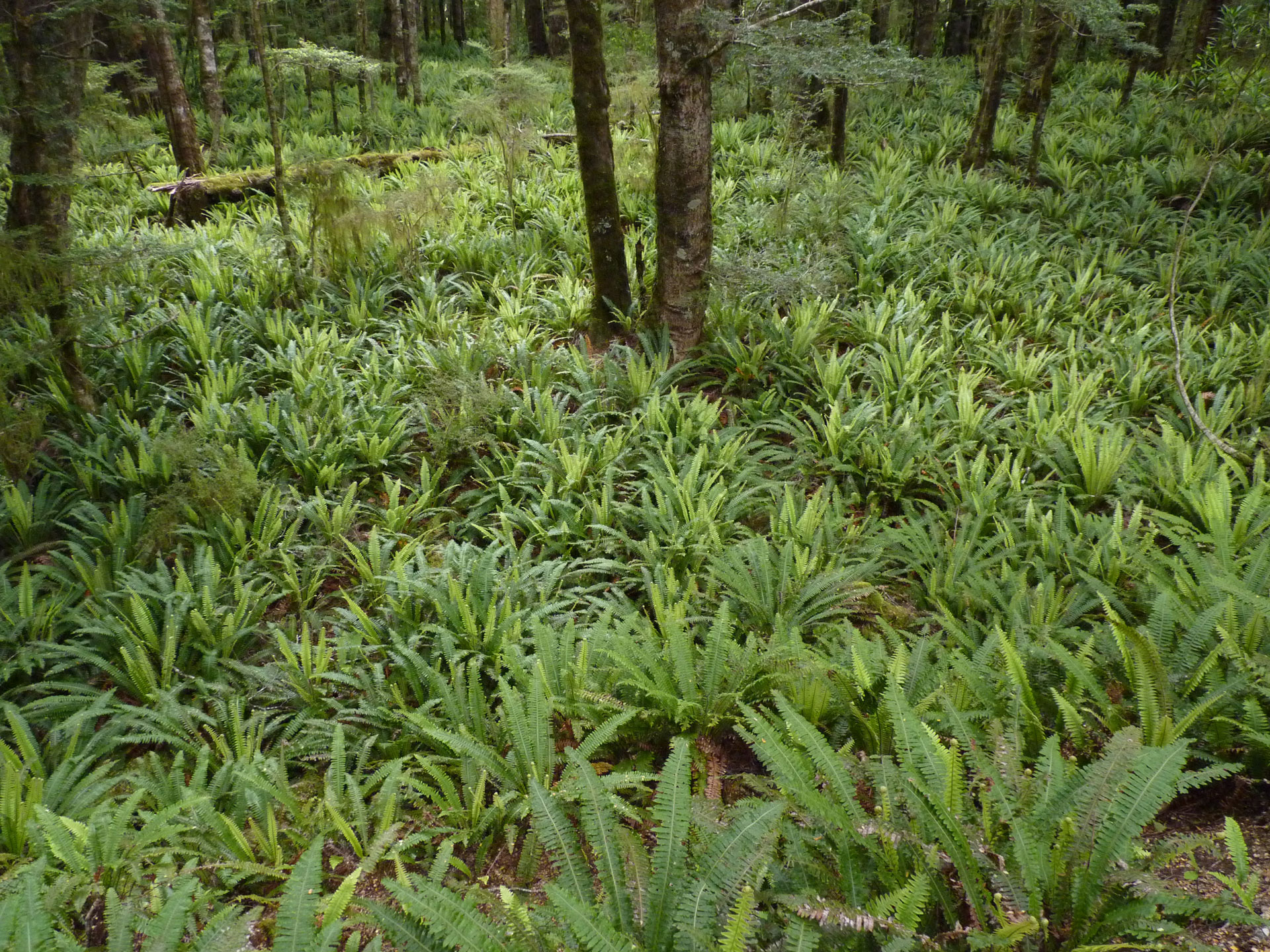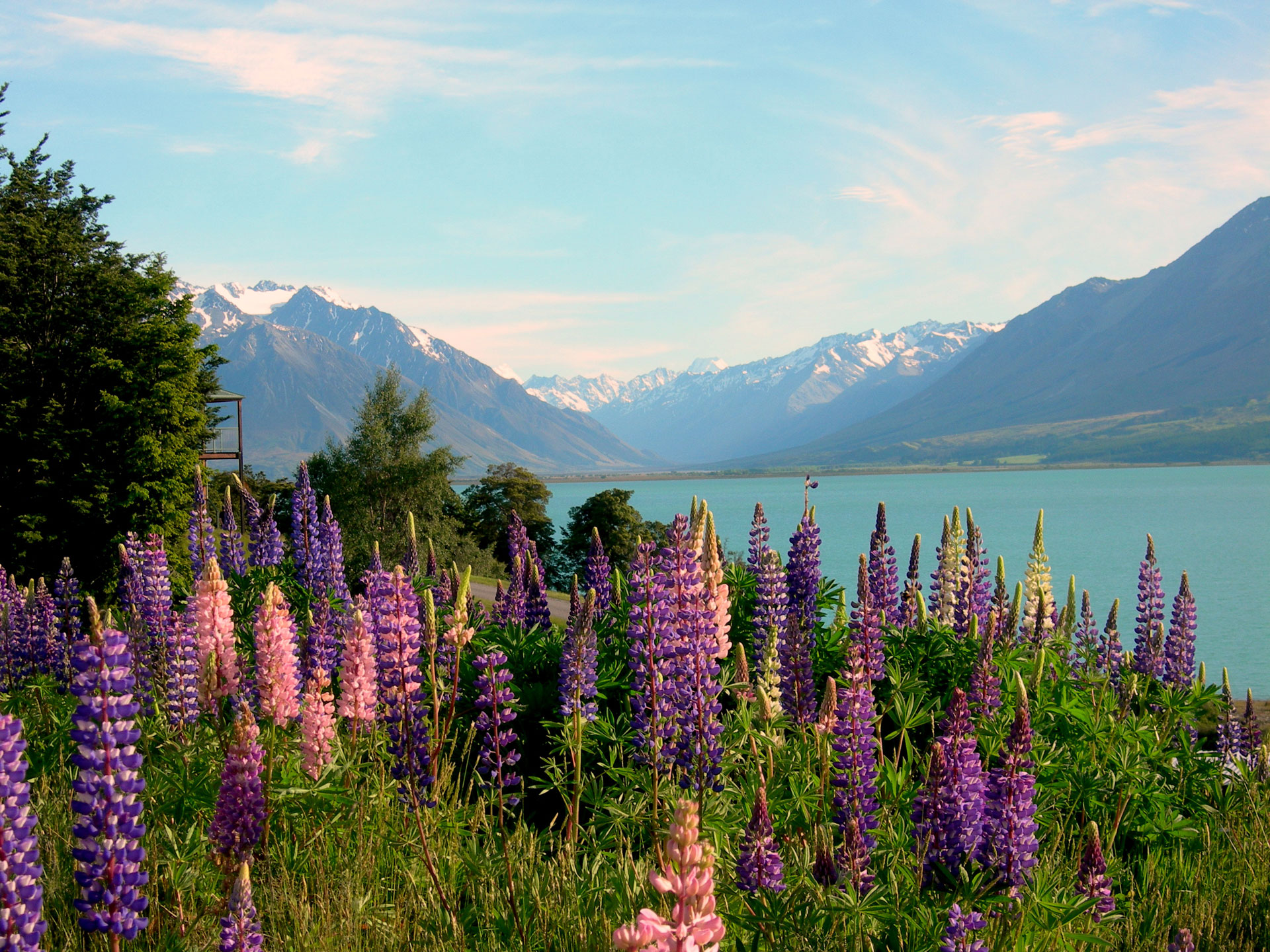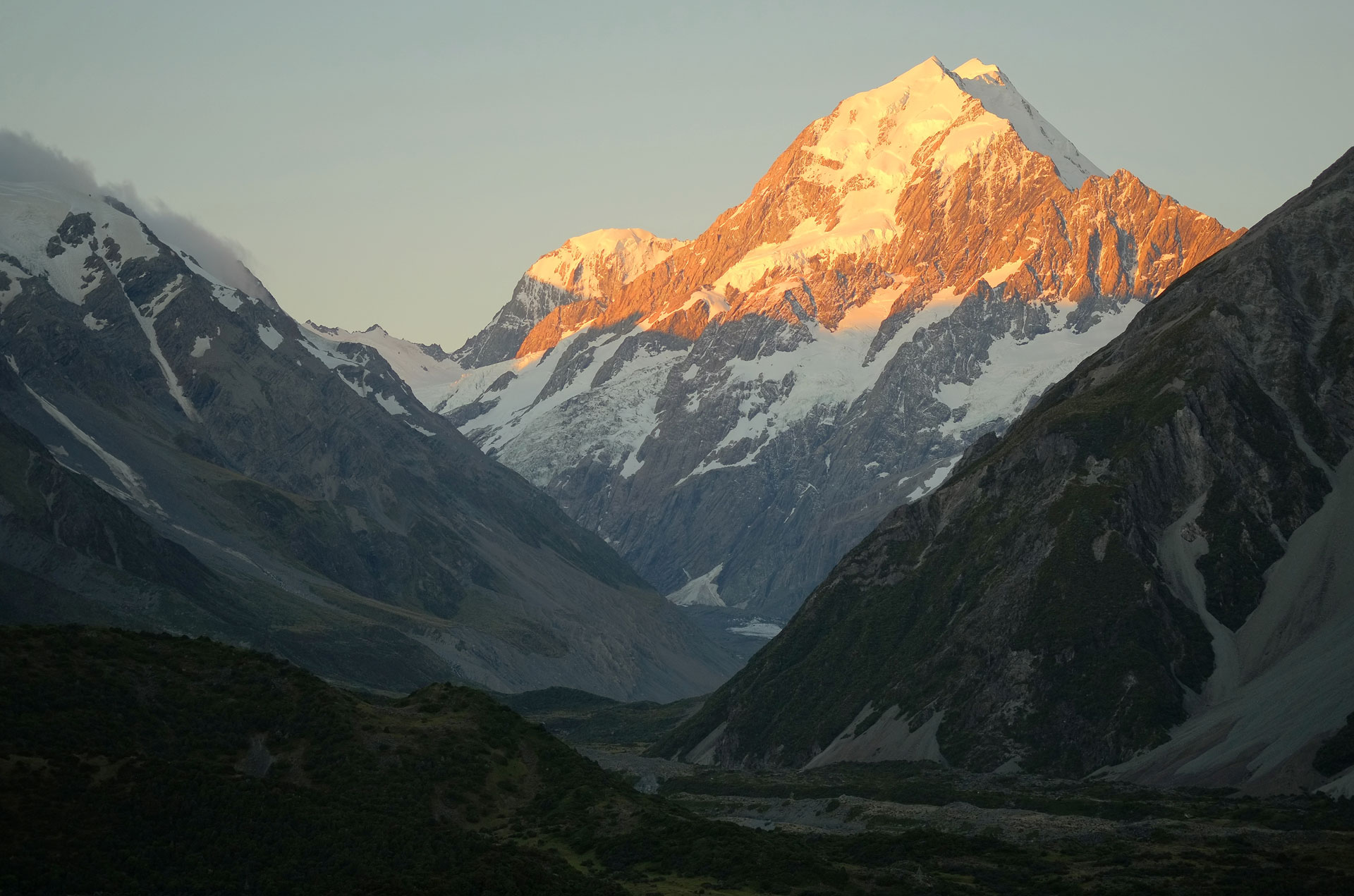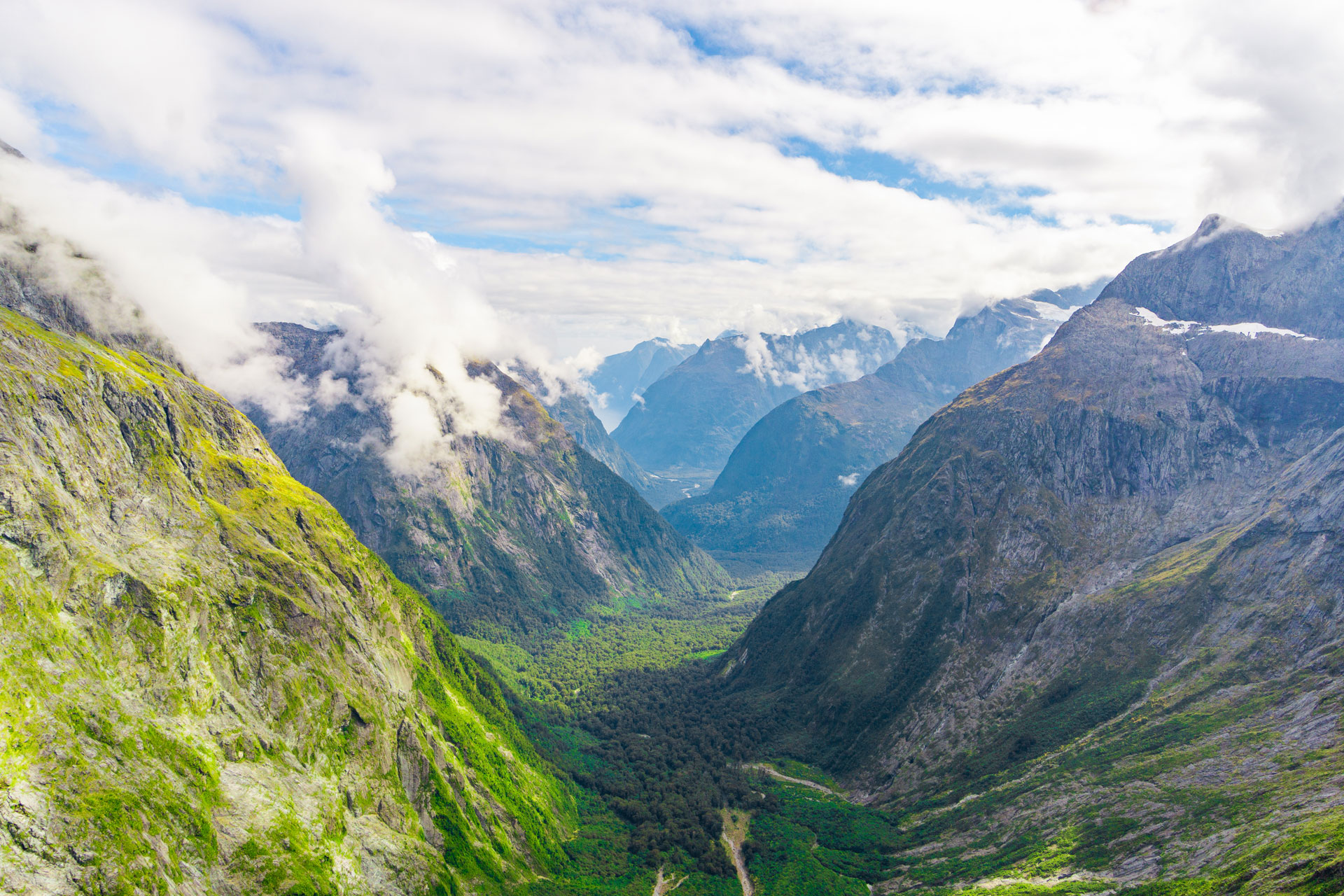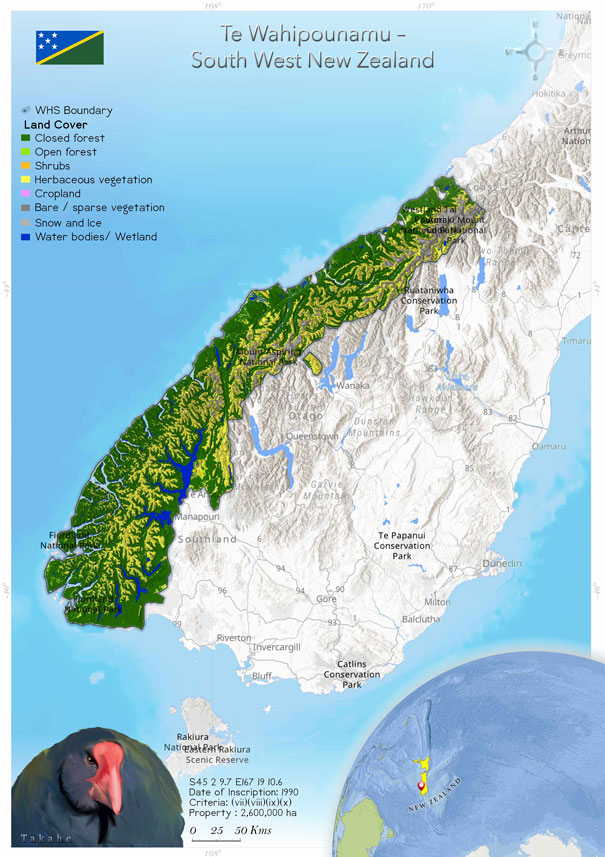
Te Wahipounamu South West New Zealand (551)
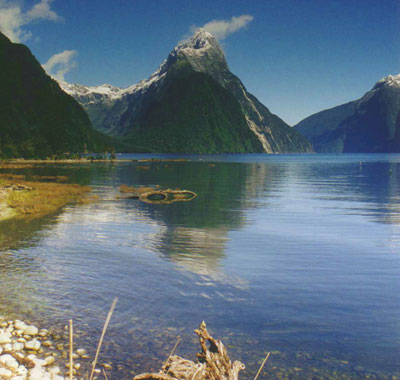 Te Wahipounamu - South West New Zealand was inscribed as a World Heritage Site in1990 under the Natural category. The property exhibits many classic examples of the tectonic, climatic, and glacial processes that have shaped the earth. It includes four national parks, two nature reserves, three scientific reserves, 13 scenic reserves, four wildlife management reserves, five ecological areas, 12 conservation areas and one private reserve. This site has the largest breeding aggregations of the New Zealand fur seal and 16 species of native freshwater fish. The area also contains the largest and most significant forest bird and wading bird populations in New Zealand, most of these species being endemic. Current threats to the property include alien species invasions, range reductions of species and significant declines in the abundance of some indigenous life forms. There is some evidence of the effects of global warming on the permanent ice fields and glaciers in the region. New Zealand lies at the edge of the Australian and Pacific tectonic plates. These two plates perform small, rapid motions, each of which is accompanied by oneor more earthquakes or tsunamis. Overall, the site management system is effective, and the property remains "good with some concerns".
Te Wahipounamu - South West New Zealand was inscribed as a World Heritage Site in1990 under the Natural category. The property exhibits many classic examples of the tectonic, climatic, and glacial processes that have shaped the earth. It includes four national parks, two nature reserves, three scientific reserves, 13 scenic reserves, four wildlife management reserves, five ecological areas, 12 conservation areas and one private reserve. This site has the largest breeding aggregations of the New Zealand fur seal and 16 species of native freshwater fish. The area also contains the largest and most significant forest bird and wading bird populations in New Zealand, most of these species being endemic. Current threats to the property include alien species invasions, range reductions of species and significant declines in the abundance of some indigenous life forms. There is some evidence of the effects of global warming on the permanent ice fields and glaciers in the region. New Zealand lies at the edge of the Australian and Pacific tectonic plates. These two plates perform small, rapid motions, each of which is accompanied by oneor more earthquakes or tsunamis. Overall, the site management system is effective, and the property remains "good with some concerns".
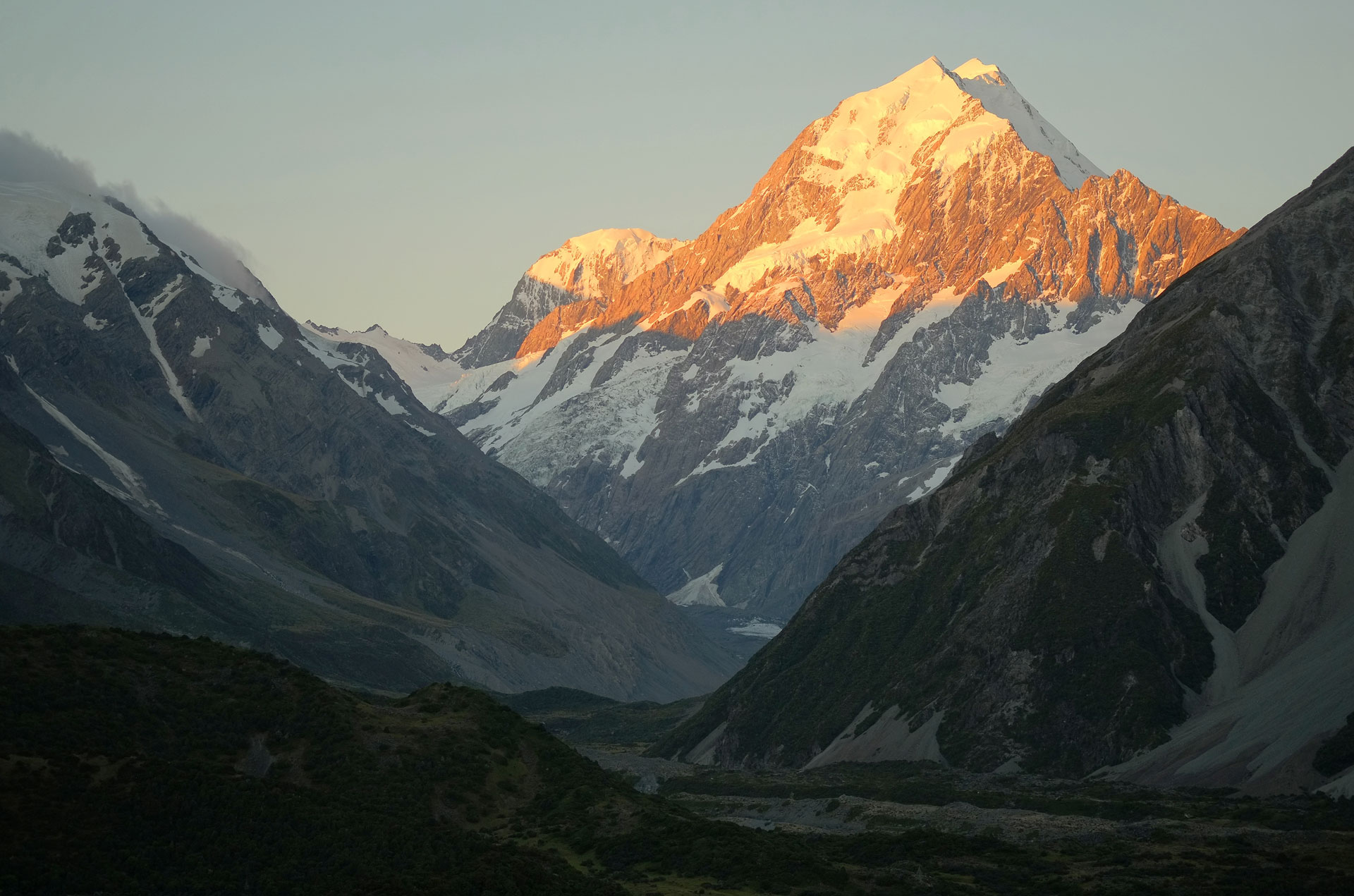 Te Wahipounamu - South West New Zealand is located in the south-west corner of New Zealand’s’ South Island (45° 2' 9.7" S, 167° 19' 10.6" E). It spreads over 10% of New Zealand’s landmass (2.6 million ha or 16 km2) and extends 40-90 km inland from the Tasman Sea as a 450 km long strip. The area is within the ancestral territories of the Ngai Tahu tribe (UNESCO WHC 2017). The climate is cool temperate oceanic. In summer the temperatures are around 20°C, and in winter the temperatures are between 5°C and 10°C (Meteovista 2017). Rain falls throughout the year, 3000-5000 mm on the coastal lowlands and 12,000 mm on the western flank of the mountains, as snow (DOC 1989). The humidity is around 80% all-round the year (World Weather and Climate 2017).
The south-west coast has the largest breeding aggregations of the New Zealand fur seal (Arctocephalus forsteri) except for the outlying Bounty Islands. The south-west is also home to the endemic Fiordland crested penguin Eudyptes pachyrhynchus (VU), with some 1000-2000 pairs breeding. More than 100 species of birds have been recorded in the World Heritage area, more than half the breeding species of New Zealand, 28 of them threatened, restricted to two localities in the north of the park are the entire populations of the two rarest of the country’s six species of kiwi. A number of mammals have been introduced, which has had severe impacts on the vegetation and ground-nesting birds. These include three species of rat (Rattus spp.), stoat (Mustela erminea), brushtail possum (Trichosurus vulpecula), wild boar (Sus scrofa), fallow deer (Cervus dama), wapiti (red deer, Cervus elaphus), Himalayan tahr (Hemitragus jemlahicus, 600 within the parks), goat (Capra hircus) and northern chamois (Rupicapra rupicapra). Very little information is known about the lizards of the site. An endemic, the Fiordland skink (Origosoma acrinasum) is found here, and the forest gecko (Haplodactylus granulatus) is probably a species distinctive to the south-west. The diversity of alpine and sub-alpine invertebrates is high, with 60% of New Zealand’s known species present, including half of New Zealand’s 1500 moths. Eleven species of butterfly are also found, including the rare black mountain ringlet, which is found above 1800m (Frimmel, 2001b). The 16 species of native freshwater fish is an exceptionally large number relative to the rest of New Zealand.
The combination of geological and climatic processes, the resultant landforms, the unique biota displaying evolutionary adaptation over a diverse range of climatic and altitudinal gradients. all in a relatively pristine state, gives Te Wahipounamu - South West New Zealand its exceptional and outstanding natural characteristics.
Te Wahipounamu - South West New Zealand is located in the south-west corner of New Zealand’s’ South Island (45° 2' 9.7" S, 167° 19' 10.6" E). It spreads over 10% of New Zealand’s landmass (2.6 million ha or 16 km2) and extends 40-90 km inland from the Tasman Sea as a 450 km long strip. The area is within the ancestral territories of the Ngai Tahu tribe (UNESCO WHC 2017). The climate is cool temperate oceanic. In summer the temperatures are around 20°C, and in winter the temperatures are between 5°C and 10°C (Meteovista 2017). Rain falls throughout the year, 3000-5000 mm on the coastal lowlands and 12,000 mm on the western flank of the mountains, as snow (DOC 1989). The humidity is around 80% all-round the year (World Weather and Climate 2017).
The south-west coast has the largest breeding aggregations of the New Zealand fur seal (Arctocephalus forsteri) except for the outlying Bounty Islands. The south-west is also home to the endemic Fiordland crested penguin Eudyptes pachyrhynchus (VU), with some 1000-2000 pairs breeding. More than 100 species of birds have been recorded in the World Heritage area, more than half the breeding species of New Zealand, 28 of them threatened, restricted to two localities in the north of the park are the entire populations of the two rarest of the country’s six species of kiwi. A number of mammals have been introduced, which has had severe impacts on the vegetation and ground-nesting birds. These include three species of rat (Rattus spp.), stoat (Mustela erminea), brushtail possum (Trichosurus vulpecula), wild boar (Sus scrofa), fallow deer (Cervus dama), wapiti (red deer, Cervus elaphus), Himalayan tahr (Hemitragus jemlahicus, 600 within the parks), goat (Capra hircus) and northern chamois (Rupicapra rupicapra). Very little information is known about the lizards of the site. An endemic, the Fiordland skink (Origosoma acrinasum) is found here, and the forest gecko (Haplodactylus granulatus) is probably a species distinctive to the south-west. The diversity of alpine and sub-alpine invertebrates is high, with 60% of New Zealand’s known species present, including half of New Zealand’s 1500 moths. Eleven species of butterfly are also found, including the rare black mountain ringlet, which is found above 1800m (Frimmel, 2001b). The 16 species of native freshwater fish is an exceptionally large number relative to the rest of New Zealand.
The combination of geological and climatic processes, the resultant landforms, the unique biota displaying evolutionary adaptation over a diverse range of climatic and altitudinal gradients. all in a relatively pristine state, gives Te Wahipounamu - South West New Zealand its exceptional and outstanding natural characteristics.
Criterion (vii)
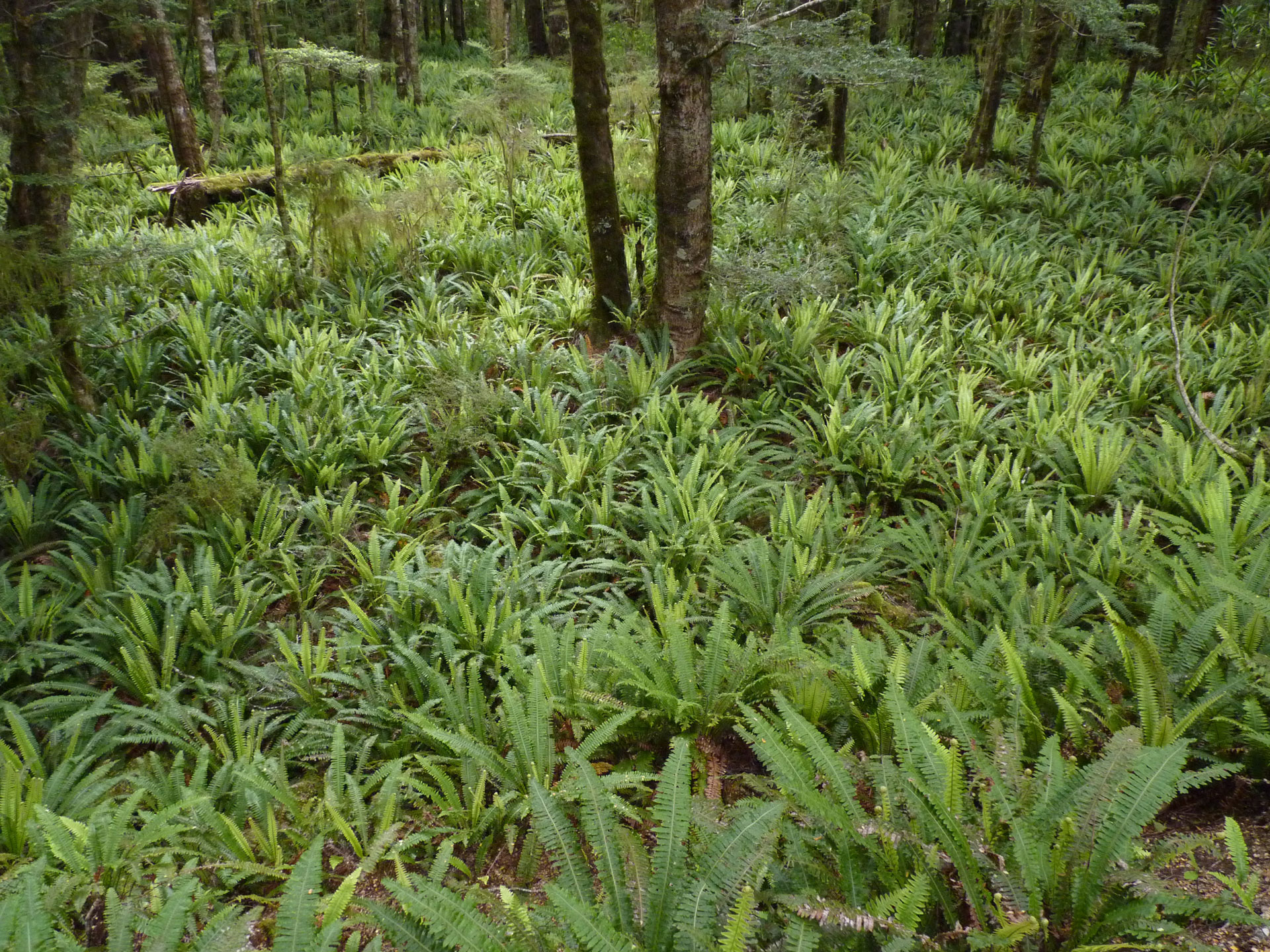 TeWähipounamu - South West New Zealand contains many of the natural features which contribute to New Zealand's international reputation for superlative landscapes: its highest mountains, longest glaciers, tallest forests, wildest rivers and gorges, most rugged coastlines and deepest fiords and lakes, as well as the remnant of an extinct volcano in Solander Island. The temperate rainforests of the property are unmatched in their composition, extent and intactness by any such forests anywhere in the world.
From the vast wilderness of Fiordland in the south to the spectacular upthrust of the Southern Alps in the north, the landscapes are world class for the sheer excellence of their scenic beauty. It is an area of magnificent primeval vistas: snow-capped mountains, glaciers, forests, tussock grasslands, lakes, rivers, wetlands and over 1000km of wilderness coastline. Only traces of human influence are evident and then mainly in peripheral areas.
TeWähipounamu - South West New Zealand contains many of the natural features which contribute to New Zealand's international reputation for superlative landscapes: its highest mountains, longest glaciers, tallest forests, wildest rivers and gorges, most rugged coastlines and deepest fiords and lakes, as well as the remnant of an extinct volcano in Solander Island. The temperate rainforests of the property are unmatched in their composition, extent and intactness by any such forests anywhere in the world.
From the vast wilderness of Fiordland in the south to the spectacular upthrust of the Southern Alps in the north, the landscapes are world class for the sheer excellence of their scenic beauty. It is an area of magnificent primeval vistas: snow-capped mountains, glaciers, forests, tussock grasslands, lakes, rivers, wetlands and over 1000km of wilderness coastline. Only traces of human influence are evident and then mainly in peripheral areas.
Criterion (viii)
TeWähipounamu - South West New Zealand is considered to be the best modern example of the primitive taxa of Gondwanaland seen in modern ecosystems - and as such the property is of global significance. The progressive break-up of the southern super-continent of Gondwanaland is considered one of the most important events in the earth’s evolutionary history. New Zealand’s separation before the appearance of marsupials and other mammals, and its long isolation since, were key factors enabling the survival of the ancient Gondwanan biota on the islands of New Zealand to a greater degree than elsewhere. The living representatives of this ancient biota include flightless kiwis, carnivorous land snails, 14 species of podocarp and genera or beech. The South West is also an outstanding example of the impact of the Pleistocene epoch of earth history. Ice-carved landforms created by these "Ice Age" glaciers dominate the mountain lands, and are especially well-preserved in the harder, plutonic igneous rocks of Fiordland. Glacier-cut fiords, lakes, deep U-shaped valleys, hanging valleys, cirques, and ice-shorn spurs are graphic illustrations of the powerful influence of these glaciers on the landscape. Depositional landforms of Pleistocene glacial origin are also important, especially in Westland, west of the Alpine Fault. Chronological sequences of outwash gravels, and moraine ridges in elegant curves and loops, outline the shapes of both former piedmont glaciers and Holocene "post-glacial" valley glaciers.
Criterion (ix)
A continuum of largely unmodified habitats, the property exhibits a high degree of geodiversity and biodiversity. Fresh-water, temperate rainforest and alpine ecosystems are all outstandingly well represented over an extensive array of landforms and across wide climatic and altitudinal gradients. Notable examples of on-going biological processes can be found in the large expanses of temperate rainforest, the plant succession after glacial retreat, soil/plant chronosequences on beach ridges, plant succession on alluvial terraces, vegetation gradients around the margins of glacial lakes and ecotypic differentiation of plants on ultramafic soils. The extensive and little modified freshwater habitats, theimpressive diversity of alpine ecosystems, extensive alpine plant endemism, and on-going evolution associated with long-standing geographical isolation of animal populations, like the kiwi taxa of South-Westland, are further examples of on-going biological evolution. While there is little permanent physical evidence of past human interaction with the natural environment, tangata whenua (the indigenous people who have customary authority in a place) have long associations with the area which was significant to them for natural resources, particularly pounamu (nephrite). European associations are more recent and initially based on natural resource exploitation. The predominant human uses today are associated with sustainable tourism.
Criterion (x)
The habitats of TeWähipounamu contain an extensive range of New Zealand’s unusual endemic fauna, a fauna which reflects its long evolutionary isolation and absence of mammalian predators. The property contains the entire wild population of the rare and endangered takahë (Notornis mantelli), the entire population of the South Island subspecies of brown kiwi (Apteryx australis), New Zealands rarest Kiwi, the rowi (Apteryx rowi), the only significant remaining populations of the seriously declining mohua / yellowhead (Mohouaochrocephala), the only large populations remaining of käkä and käkäriki / yellow-crowned parakeet, the only remaining population of pateke / Fiordland brown teal in the South Island. The world's rarest and heaviest parrot, käkäpö (Strigopshabroptilus) survived in Fiordland until the early 1980s. It is now thought to be extinct on the mainland and its survival depends on careful management of a limited number of offshore island populations.
Status
The State of Conservation (SoC) reports (https://whc.unesco.org/en/soc/1409) state that the use of transportation infrastructure is affecting the property. As per the SOC report of 2004, there was an oil-spill accident at Te Wahipounamu – South West New Zealand. The report indicates that approximately 13,000 litres of diesel fuel spilled into the harbour at Freshwater Basin, at the head of Milford Sound, which borders Fiordland National Park, part of the World Heritage property. The management of the oil-spill response plan indicates that the marine reserve at Milford Sound appears not to have been adversely affected by the spill. With respect to the adverse impact on wildlife, immediate and follow-up actions have not revealed any issues of immediate concern, and it is assumed that there will be no long-term threats. Furthermore, a thorough clean-up operation has been completed with the support of the community. IUCN World Heritage Outlook's evaluation of heritage sites reveals that that low-level threats are posed by grazing and mining operations. Potential threats include a growing demand for development of tourism facilities, including new road corridors and increased aircraft access. High levels of threat are posed by the effects of climate change on the distribution of the vegetation, habitat fragmentation, alien species invasions and the already marked reduction in the volume of permanent ice. The state of conservation of the site is considered to be good with some concerns, and the management of the area and the quality of its values remain stable. Overall, the protection and management of the property can be assessed as effective.
